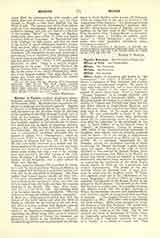

Aelfric, ABBOT OF EYNSHAM, also known as “the Grammarian,” the author of Homilies in Anglo-Saxon, a translator of Holy Scripture, and a writer upon many miscellaneous subjects. He seems to have been born about 955, and to have died about 1020. The identity of this writer has been the subject of much controversy. Even in Freeman’s “Norman Conquest” he is wrongly identified with Aelfric, Archbishop of Canterbury (1005). But of late years nearly all scholars have come round to the opinion of Lingard and Dietrich that there was but one Aelfric famous in Anglo-Saxon literature, and that this man was never raised to any higher dignity than that of abbot. Of his career we know but little. He was undoubtedly a monk of the Old Monastery of Winchester under Saint Athelwold, whose life he subsequently wrote in Latin. Some time after his ordination to the priesthood, he was sent to Cerne Abbey, or as he himself writes it “Cernel”, in Dorsetshire. Thence he became, in 1005, abbot of the recently-founded monastery of Eynsham, near Oxford, where he probably remained until his death. Of all the writers in Anglo-Saxon that have been preserved to us Aelfric was the most prolific. He is especially remembered for his Homilies, around the theological teaching of which concerning the Blessed Sacrament a great controversy has raged. Already in the reign of Queen Elizabeth it was asserted by Mathew Parker, Archbishop of Canterbury, that Aelfric in his Homily for Easter Day clearly evinced his disbelief in Transubstantiation, and that he must, moreover, be regarded as expressing the sentiments of the whole Anglo-Saxon church, of which he was a prominent and trusted representative. The details of the controversy cannot be discussed here. It may, preexistence, be noted that the Anglican writer, W. Hunt, who eighteen years ago in the “Dictionary of National Biography” described Aelfric as vigorously opposing “the doctrine of the Roman Church on the subject of the Eucharist,” has recently so far modified his view as to allow that “it is possible to reconcile Aelfric’s words with the present teaching of Rome; his expressions are loose and unphilosophical, and, therefore, capable of being interpreted according to demand.” (“The English Church to the Norman Conquest,” p. 376.) This latter view is undoubtedly the more correct. Aelfric never intended to attack the doctrine of the Real Presence. He quotes with approval instances of the miraculous appearance of blood at the breaking of the Host. But he had adopted the views of Ratramnus of Corbie, whom he repeatedly paraphrases, insisting that in the Eucharist was a “spiritual” presence as opposed to a “bodily” (i.e., fleshly or carnal) one. That Ratramnus was no opponent of Transubstantiation has recently been proved to demonstration in the monograph of Dr. August Nagle (Vienna, 1903). Aelfric’s numerous works in Anglo-Saxon, which give evidence of much literary power, have now nearly all been printed. Both the “Catholic Homilies” and the “Homilies on the Saints” have been edited with translations; the former in 1846, by Thorpe; the latter in 1900, by Skeat.
HERBERT THURSTON

